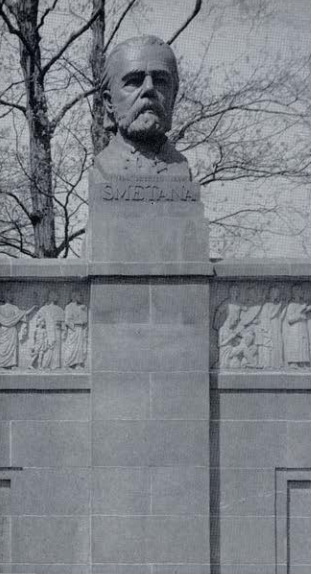Part Two. Links in the Chain: History of the Cultural Gardens
Czech Cultural Garden


In the Czech Cultural Garden are depicted the arts of the Bohemian, Moravian, and Silesian peoples. Dedicated in 1935, it is located on the upper East Boulevard drive, about 150 yards south of the intersection of, the boulevard with St. Clair Avenue, its west boundary extending down to the lower East Boulevard drive. A circular lawn bordered by hedges and flanked by rose beds was designed by landscape architects, B. Ashburton Tripp and Maurice Cornell.
Forming the top border of a monumental stone wall is a sculptured frieze portraying the discovery of Bohemia and the American migration of the Czech people, hearing their rich cultural gifts. Surmounting the wall and facing the lawn is a series of $xu bronze heroic busts of celebrated Czech personages. These are Bedrich Smetana (1824 lS84), composer of the popular comic opera, “The Bartered Bride”; Dr. Miroslav Tyrs (1832-1884), educator and organizer of Sokol gymnastic societies: Jan E. Purkyne (1787-1869), physiologist; and Dozena Nemcova (1820-1862). ‘woman novelist, famous for her book, “Babicka” (Little Grandmother).
Other busts in the Czech Garden have been raised to Frantisek Palacky (1798-1876), historian and statesman, and author of a “History of Bohemia”; Anton Dvorak (1841-1904), world-renowned composer whose impressions of America are portrayed in his beloved “New World Symphony”; the Reverend Jendrich Simon Baar (1869-1929), priest and novelist; and Karl Havlicek (1821-1856), publicist and journalist, who suffered imprisonment because of his fearless expression of patriotism and liberal views.
All the busts in the Czech Garden, as well as the wall frieze, are the work of Frank L. Jirouch, Cleveland-born sculptor of Czech descent.
Czech Garden activity has been notably vigorous since 1929, when a committee composed of Mrs. Marie Zeman, the Reverend Oldrich Zlamal, and Joseph Nemastil was formed, with Mr. Edward Kovanda as president, Mrs. Marie Ruzicka as vice-president, and MIS. Roberta ,Manak as treasurer. On January 31, 1935, an exhibit of Czech art objects, arranged by Mrs. Manak, was held at the Higbee Company, by which means funds were obtained and interest stimulated in the Czech Garden project. Czech lodges and Czech Catholic parishes were contacted and plans were drawn up by Frank Jirouch. Edward Kovanda, and Frank Vlchek for the setting out of trees, shrubbery, and monuments in a garden to cover about an acre of ground in the Cultural Garden chain.

A permanent Czech Garden organization was formed soon after, with Edward Koster, Fred Holub, John Babka, Dr. E. Zeleznik, the Reverend V. Louzecky, and Alfred A. Benesch augmenting the previously formed committee. Permanent officers, elected during 1936, were E. C. Koster, president; Fred Holub, Bernard Plent, and Vaclav Frcka, vice-presidents; Marie A. Ruzicka, secretary; Marie Zeman, assistant secretary; Rose Dvorak, financial secretary; and Rose Triska, treasurer.
A three-year period of fund-raising card parties and social affairs enabled the group to proceed with the building of the garden proper. Many efforts, together with Federal and City aid, and the donations of statues by prominent Cleveland Czechs, enabled the treasury to complete the garden.
The Purkyne bust was donated by Victor Ptak, the Tyrs bust by Sokols Tyrs, the Dvorak bust by Prank C. Manak, the Palacky bust by a group of Cleveland Catholic clergy, the Smetana bust by Thomas 1;. Sidlo, and the Nemcova bust by Mrs. Edward Nosek.
Frank Manak served as president from 1928 to 1940, and Herbert Zdara from 1941 to 1949, when the Tyrs, Nemcova, and Purkyne busts were placed and dedicated. Frank Bubna, at the present writing, is president.
The Czech Cultural Garden plot was dedicated on Sunday, October 6, 1935. Ceremonies began with the singing of the Star Spangled Banner. Officers of the Cultural Gardens League were presented to the assembled crowd. Addresses were delivered by William R. Hopkins, Harry L. Davis, then Mayor of Cleveland, Dr. Jaroslav Gardavsky, Czechoslovak Consul of Cleveland, and Professor Frank Bican. Musical selections were rendered by the Lumir-Hlahol and Vojan Singing Societies. Marie Zeman, Marie Ruzicka, and Monsignor Zlamal collaborated on a number of the program entitled “The Czech Cultural Garden”, and the trees in the garden were decorated with fillets designed and donated by Tonca Janovska of Praha.

On April 1, 1939, two linden trees from Bohemia were planted in the Czech Garden by President and Madam Benes of Czechoslovakia. This event typified the transplanting to the new world of the ideals of freedom and the rich culture of the Czech people, who first came to America as early as 1648,and gave us, in William Paca, a signer of the Declaration of Independence. Moravian missionaries did much to protect the early Colonists by teaching peace and faith to the Indians.
In 1786, ten years before the arrival at the Cuyahoga, of Moses Cleaveland and his surveyors, Moravian missionaries were building a settlement in the Cuyahoga Valley at the junction of the river and’ Tinker’s Creek. Headed by Zeisberger and Heckewelder the group reared a number of log cabins and a chapel, and bestowed the name “Pilgeruh” or Pilgrim’s Rest upon the tiny settlement. Owing to the hostility of the Indians the venture did not prove successful and in time practically every trace of the buildings vanished.

From 1845 to the First World War, countless Czech immigrants enriched America’s farmlands and cities with their courage and industry. To the nobility alike of their labor and aspirations, the Czech Cultural Garden is dedicated as a memorial.
